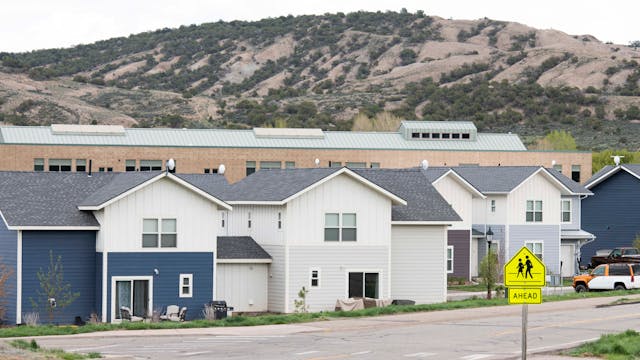Today, a 20-acre stretch of green space known as the “Coy facility” remains an active school campus in East Austin. But soon, Austin Independent School District will convert it into an apartment complex to house teachers and staff who are increasingly getting priced out of the urban Texas district.
The goal is to create at least 500 new rental units on the site, alleviating — if not solving — the housing burden that so many of the district’s 10,000 staff members say they face.

Scores of districts across the country are undertaking similar projects, as a lack of affordable housing in parts of the United States has led teachers to shoulder long commutes, decline job offers and vacate their positions altogether.
This year, EdSurge has been reporting on the relationship between America’s housing crisis and high teacher turnover rates in K-12 education.
In our first story, we explored the impact of rising housing costs on teacher shortages by visiting a rural mountain community where this crisis is playing out in real time. Then, we highlighted a school district in the San Francisco Bay Area where an affordable housing complex built on district-owned land and occupied exclusively by teachers and school-based staff is already showing signs of success.
Over the past six months, we have spoken with teachers and school support staff from rural and urban districts whose modest salaries are not keeping pace with the housing prices in their communities. We’ve interviewed education researchers, district leaders and economists about what both the data and anecdotal evidence reveal about this dynamic. We’ve scoured local and state news sources, case studies and reports to understand the different solutions being proposed and implemented. And we took two reporting trips to visit school districts that are considering — or have already begun — construction on housing projects for staff.
Here are the key takeaways from our reporting:
1. The rising cost of housing is driving teachers and support staff out of their schools and communities.
The costs of both renting and buying have increased dramatically since the pandemic, and teacher salaries have not been able to keep pace with that growth rate. In areas where housing prices and the cost of living are especially high, turnover rates have reached alarming levels.
Jefferson Union High School District, located in the San Francisco Bay Area, had been losing between 20 and 25 percent of staff annually before opening an apartment complex on district-owned land last year.
“We kept hearing, ‘It’s not because we don’t want to work here. It’s because we can’t live here,’” says Austin Worden, director of communication and staff housing for the district.
At Eagle County School District, in Colorado, turnover hovers around 20 percent annually. “We continue to be short-staffed in every department,” a district official shares.
In both districts, the median sales price for a home exceeds $1 million, and rental rates for a one-bedroom apartment can easily cost $2,000 a month or more.

In Austin, Texas, as newcomers arrive to the city and housing prices balloon, many education staff are being pushed farther and farther into the suburbs. Some eventually may be forced to leave the district or find higher-paying professions.
“More than half my paycheck goes to rent and living expenses… Many of us are resigning because of it,” one Austin ISD staff member shared in a district survey conducted earlier this year, which found that 74 percent of staff spend more than 30 percent of their salary on housing.
Another educator wrote that while their salary increased 8 percent the previous year, their rent went up 22 percent. “This is not sustainable and will eventually drive me out of the city I teach in.”
2. In many areas, teachers can’t afford to rent or buy — and the data supports the anecdotes.
Earlier this year, Patricia Saenz-Armstrong, senior economist at the National Council on Teacher Quality (NCTQ), analyzed housing costs in 69 large metropolitan areas across all 50 states against teacher salaries at the largest school districts in those areas, then published her findings in a report.
In 15 of the 69 metro areas, she found that renting a one-bedroom apartment would be unaffordable for an early-career teacher (where “affordability” is defined using the U.S. Department of Housing and Urban Development’s definition). And in six of those metro areas, it would take a teacher at least 20 years to save up enough money for the average down payment on a house.
A prohibitively high cost of living is not limited to cities. In regions across the country, from California to North Carolina — including resort communities such as Eagle County — renting and buying can be difficult endeavors, especially for public school teachers, for whom the national average salary is about $67,000.
3. The resulting turnover rates have an impact on students and school communities.
The stakes are high. When a school district must replace one in five of its staff members every year — as would be the case for a district with a 20 percent annual turnover rate — educators, students, families and the entire community are impacted.
“You lose your skill and capacity in a school when you keep bringing in new teachers who don’t have experience,” says Heather Peske, president of NCTQ. “When teachers leave, [their] knowledge and skills and the investments districts have made go out the door. The district has to start again with a new crop of teachers.”
Over time, students in high-turnover districts are often taught by less experienced, less qualified teachers. That has a cumulative impact — especially when research shows that teachers have a bigger influence on student achievement than any other school-based factor.
“If every year the campus staff looks different, that really impacts that campus and how it functions,” acknowledges Jeremy Striffler, director of real estate for Austin ISD. “We also know that if we can't fill positions, there's the threat of larger class sizes, there's the threat of school closures, etc. So we need to do what we can to attract and retain employees.”
4. Desperate to slow attrition, school districts are getting involved.
District leaders may not be prepared to spearhead housing development projects. But desperate times call for desperate measures.
“They don’t have the time or the luxury of thinking, ‘Is this my job?’” notes Peske, adding that district leaders’ responsibility is to ensure a stable, effective educator workforce.
Some have tried appealing to their communities. In Eagle County and elsewhere, district leaders have asked homeowners to open their homes to educators, letting them rent out spare rooms and lofted garages. A district in Arizona recently broke ground on a project to build tiny homes for teachers. One in Texas bought a motel, renting the rooms at a heavily discounted price to housing-strapped district staff.
The most popular response, though, is what the districts in Austin, Eagle County and the Bay Area are all doing: building housing complexes on district-owned land.
Many school districts are land-rich and are starting to make use of that asset. In California alone, at least 46 school districts were pursuing workforce housing projects as of March 2022.
Across the country, district-led efforts to provide housing for teachers are in varied stages. The housing complex for staff at Jefferson Union High School District opened more than a year ago. Early results indicate it’s working as designed; staff vacancies are down and retention is up. Through a lottery system, Eagle County Schools recently matched staff with units in its forthcoming apartment building, which will become available in phases, starting this fall. For those who were matched, it’s poised to be a game-changer. But there aren’t enough units to serve all of the educators who expressed need.
Austin’s plans are not quite as mature. Construction hasn’t yet begun, and Striffler estimates that staff are years away from being able to move into the eventual building.
“We just feel that we have these assets here — we have this underutilized land — and that we can put it to good use by building housing, which can hopefully keep our teachers and staff here in the community that they're serving,” Strifler says.
These efforts will help many educators’ housing woes, but they’re unlikely to remedy the problems entirely, district leaders admit.
“I don’t know if it will ever be solved,” says Matthew Miano, a spokesperson for Eagle County Schools, “but we will continue to chip away at it.”


